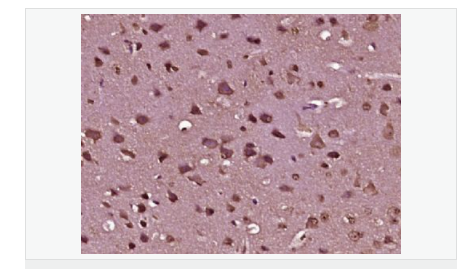

貨號(hào)
產(chǎn)品規(guī)格
售價(jià)
備注
BN40558R-100ul
100ul
¥2360.00
交叉反應(yīng):Mouse,Rat(predicted:Human,Dog,Pig,Cow,Horse,Rabbit,Sheep) 推薦應(yīng)用:WB,IHC-P,IHC-F,ICC,IF,ELISA
BN40558R-200ul
200ul
¥3490.00
交叉反應(yīng):Mouse,Rat(predicted:Human,Dog,Pig,Cow,Horse,Rabbit,Sheep) 推薦應(yīng)用:WB,IHC-P,IHC-F,ICC,IF,ELISA
產(chǎn)品描述
| 英文名稱 | Prune homolog 2/C9orf65 |
| 中文名稱 | 9號(hào)染色體開(kāi)放閱 |
| 別 名 | A214N16 3; BCH motif containing molecule at the carboxyl terminal region 1; BMCC1; BNIP2 motif containing molecule at the carboxyl terminal region 1; BNIPXL; C9orf65; chromosome 9 open reading frame 65; prune homolog 2 (Drosophila); Prune2. |
| 研究領(lǐng)域 | 細(xì)胞生物 免疫學(xué) 細(xì)胞凋亡 |
| 抗體來(lái)源 | Rabbit |
| 克隆類型 | Polyclonal |
| 交叉反應(yīng) | Mouse, Rat, (predicted: Human, Dog, Pig, Cow, Horse, Rabbit, Sheep, ) |
| 產(chǎn)品應(yīng)用 | WB=1:500-2000 ELISA=1:5000-10000 IHC-P=1:100-500 IHC-F=1:100-500 ICC=1:100-500 IF=1:100-500 石蠟切片需做抗原修復(fù) not yet tested in other applications. optimal dilutions/concentrations should be determined by the end user. |
| 分 子 量 | 341kDa |
| 細(xì)胞定位 | 細(xì)胞核 細(xì)胞漿 |
| 性 狀 | Liquid |
| 濃 度 | 1mg/ml |
| 免 疫 原 | KLH conjugated synthetic peptide derived from human Prune homolog 2/C9orf56:2801-2900/3088 |
| 亞 型 | IgG |
| 純化方法 | affinity purified by Protein A |
| 儲(chǔ) 存 液 | 0.01M TBS(pH7.4) with 1% BSA, 0.03% Proclin300 and 50% Glycerol. |
| 保存條件 | Shipped at 4℃. Store at -20 °C for one year. Avoid repeated freeze/thaw cycles. |
| PubMed | PubMed |
| 產(chǎn)品介紹 | The protein encoded by this gene belongs to the B-cell CLL/lymphoma 2 and adenovirus E1B 19 kDa interacting family, whose members play roles in many cellular processes including apotosis, cell transformation, and synaptic function. Several functions for this protein have been demonstrated including suppression of Ras homolog family member A activity, which results in reduced stress fiber formation and suppression of oncogenic cellular transformation. A high molecular weight isoform of this protein has also been shown to colocalize with Adaptor protein complex 2, beta-Adaptin and endodermal markers, suggesting an involvement in post-endocytic trafficking. In prostate cancer cells, this gene acts as a tumor suppressor and its expression is regulated by prostate cancer antigen 3, a non-protein coding gene on the opposite DNA strand in an intron of this gene. Prostate cancer antigen 3 regulates levels of this gene through formation of a double-stranded RNA that undergoes adenosine deaminase actin on RNA-dependent adenosine-to-inosine RNA editing. Alternative splicing results in multiple transcript variants. [provided by RefSeq, Jul 2015] Function: Phosphodiesterase (PDE) that has higher activity toward cAMP than cGMP, as substrate. Plays a role in cell proliferation, is able to induce cell motility and acts as a negative regulator of NME1. Subunit: Homooligomer. Able to homodimerize via its C-terminal domain. Interacts with NME1. Interacts with GSK3; at focal adhesion complexes where paxillin and vinculin are colocalized. Subcellular Location: Cytoplasm. Nucleus. Cell junction ?focal adhesion Tissue Specificity: Ubiquitously expressed. Seems to be overexpressed in aggressive sarcoma subtypes, such as leiomyosarcomas and malignant fibrous histiocytomas (MFH) as well as in the less malignant liposarcomas. Similarity: Belongs to the PPase class C family. Prune subfamily. SWISS: Q8WUY3 Gene ID: 158471 Database links: Entrez Gene: 158471 Human Entrez Gene: 353211 Mouse SwissProt: Q8WUY3 Human SwissProt: Q9D217 Mouse Important Note: This product as supplied is intended for research use only, not for use in human, therapeutic or diagnostic applications. 與in isoform 2,3,4,5同源 |


